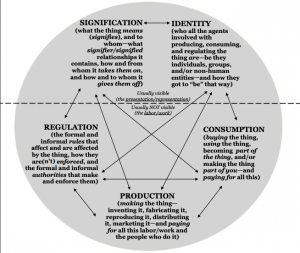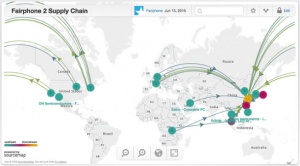Difference between revisions of "Circuit of Culture"
(image) |
(Ethics Section) |
||
| Line 16: | Line 16: | ||
The Circuit of Culture, otherwise known as “the Circuit”, was developed by Du Gay and members of the British Centre for Contemporary Cultural Studies (CCCS). Later on it was developed into an educational concept part of the 1997 Culture, Media & Identities series (Sage & Open University).<ref>History of Circuit of Culture https://files.eric.ed.gov/fulltext/ED544487.pdf </ref> | The Circuit of Culture, otherwise known as “the Circuit”, was developed by Du Gay and members of the British Centre for Contemporary Cultural Studies (CCCS). Later on it was developed into an educational concept part of the 1997 Culture, Media & Identities series (Sage & Open University).<ref>History of Circuit of Culture https://files.eric.ed.gov/fulltext/ED544487.pdf </ref> | ||
| − | == | + | ==Using the Circuit to Examine Culture & Ethical Impact== |
[[File:Walkman.jpeg|thumb|Sony Walkman - Late 90's Model]] | [[File:Walkman.jpeg|thumb|Sony Walkman - Late 90's Model]] | ||
Du Gay first chose the Sony Walkman as an exemplary artifact to be used within the Circuit. In 1997 it was a “typical cultural arterfact”<ref> Du Gay: Walkman http://clab.iat.sfu.ca/431/uploads/Site/DoingCulturalStudies.pdf</ref> because of its widespread popularity and was a “medium of modern culture” similar to a smartphone today. <ref>Times of India: Walkman and Smartphones https://timesofindia.indiatimes.com/gadgets-news/from-walkman-to-smartphones-how-portable-music-has-evolved/articleshow/79791151.cms</ref> Du Gay states that studying the Walkman’s “story” or “biography” can give insight into the structures of late modern societies and how they work.<br><br> | Du Gay first chose the Sony Walkman as an exemplary artifact to be used within the Circuit. In 1997 it was a “typical cultural arterfact”<ref> Du Gay: Walkman http://clab.iat.sfu.ca/431/uploads/Site/DoingCulturalStudies.pdf</ref> because of its widespread popularity and was a “medium of modern culture” similar to a smartphone today. <ref>Times of India: Walkman and Smartphones https://timesofindia.indiatimes.com/gadgets-news/from-walkman-to-smartphones-how-portable-music-has-evolved/articleshow/79791151.cms</ref> Du Gay states that studying the Walkman’s “story” or “biography” can give insight into the structures of late modern societies and how they work.<br><br> | ||
Revision as of 18:06, 20 April 2021
The Circuit of Culture is a framework or model of sociological analysis that can be used to define cultural products to understand the environments they exist in. It was developed in Britain in 1997 by Paul Du Gay and other colleagues who first used it to examine a Sony Walkman cassette player. [1]

Contents
Overview & Definition
The Circuit of Culture differs from traditional sociological analysis frameworks because of its holistic approach to defining a cultural artifact by exploring the relationship between 5 moments or "nodes" as opposed to a singular moment.[3] At that time, many frameworks emphasised a singular moment, production, of an artifact’s existence to determine meaning.[4] The word circuit refers to the relationship or articulation between 5 different nodes (production, consumption, identity, regulation, and signification) that gives meaning to an artifact. Du Gay et al. suggest that "taken together (these 5 points) complete a sort of circuit...through which any analysis of a cultural text...must pass if it is to be adequately studied."[5] The word culture refers to “the process by which meaning is produced, circulated, consumed, commodified, and endlessly reproduced and renegotiated in society.” [6][7][8]
History of Development
Before the Circuit of Culture was created Stuart Hall and his colleagues’ worked with the Centre for Contemporary Cultural Studies (CCCS) in Birmingham UK between 1968 -1979 and with the Open University until his retirement in 1997. Focused on construction and management of cultural phenomena, commoditization and meaning making his work provides the theoretical foundation from which this framework was developed. [9]
The Circuit of Culture, otherwise known as “the Circuit”, was developed by Du Gay and members of the British Centre for Contemporary Cultural Studies (CCCS). Later on it was developed into an educational concept part of the 1997 Culture, Media & Identities series (Sage & Open University).[10]
Using the Circuit to Examine Culture & Ethical Impact
Du Gay first chose the Sony Walkman as an exemplary artifact to be used within the Circuit. In 1997 it was a “typical cultural arterfact”[11] because of its widespread popularity and was a “medium of modern culture” similar to a smartphone today. [12] Du Gay states that studying the Walkman’s “story” or “biography” can give insight into the structures of late modern societies and how they work.
He explains that in order to attempt to understand or explore how culture works in the present day one must “focus our attention on the structure, strategy, and culture of these increasingly global commercial enterprises.” To help articulate this idea he gives an example of examining how modern cultural artifacts, like the Walkman, are produced in the contemporary world by a “relatively small band of transnational companies such as Disney Corporation, News International, and Sony.”[13]
Elements of Circuit: 5 Nodes
Production
Production refers to how the artifact is made, invented, fabricated, reproduced, distributed or otherwise produced within its cultural environment. It refers to the labor itself and the people involved. The following are questions adapted from Stuart Hill's "Representation" to help identify insights when examining the production of an artifact: [14]
- "Follow the money! Who’s paying for it, and/or backing it? Where’s the money (and other resources) coming from? Is it on Fox? Paid for in part by the Melville Trust?"
- "Who’s making or producing it? What is his/her/their story? Socio-economic background? Interests (financial and otherwise)? Personal experiences? Positions (or “biases”)?"
- "Who thought it up? (Same questions apply from above.)"
- "How different are the people who are paying for it, making it, and thinking it up? All together living in a co-op? All the same person? Paid for by a housewife in St. Cloud, made by a sweatshop laborer in Shenzhen, designed by a firm in Wayzata?"
Consumption
Consumption refers to how an artifact is bought, used, adapted to self, or otherwise consumed within its cultural environment. The following are questions adapted from Stuart Hill's "Representation" to help identify insights when examining the consumption of an artifact:[15]
- "Are the people who consume it (or use it, or do it) different from the people who produce it? If so, again as above: how different?"
- "Is it something you buy? If so, what does it cost? Who can afford it? Who can’t? Why?"
- "How, where, with whom, and why do you consume (do/watch/read/listen to/eat) it?"
- "Is it advertised or marketed? If so, how, where, why, and to whom?"
Regulation
Regulation refers to "the formal and informal rules that affect and are affected by the thing, how they are(n’t) enforced, and the formal and informal authorities that make and enforce them". [16] The following are questions adapted from Stuart Hill's "Representation" to help identify insights when examining the regulation of an artifact:[17]
- "Is it legal, or against the rules? What rules? Who makes and enforces them? How/why?"
- "Is it 'obscene'? 'pornographic'? 'subversive'? Why, and according to whom?"
- "What kind of certification, acceptance, and/or rubber-stamping do you need before you can produce or consume it? Who does this certifying, accepting, and/or rubber stamping?"
Identity
Identity refers to "all the agents involved with producing, consuming, and regulating the thing are" and "how they got to be that way". this refers to "individuals, groups, and/or non-human entities".[18] The following are questions adapted from Stuart Hill's "Representation" to help identify insights when examining the identity of an artifact:[19]
- "Who produces, consumes, and regulates it? Who would NEVER be involved with it? Why?"
- "Who cares about it? Who thinks it’s important? Why?"
- "What do others think of people who do/use it? Why?"
- "What do you have to know, understand, and believe in order to do/use it? What has to be “common sense” for you, in order to be the kind of person who does/uses it?"
- "How does the object create insiders and outsiders—or, an “us” and a “them”? Who is “us”?"
- "Who is “them”? Who decides? How?"
Signification
Signification refers to what the artifact means and "to whom—what signifier/signified relationships it contains, how and from whom it takes them on, and how and to whom it gives them off". [20] The following are questions adapted from Stuart Hill's "Representation" to help identify insights when examining the identity of an artifact:[21]
- "What does it signify (what is it a signifier for)? What signifies it (what is it a signified of)? And to whom: to its creators/authors/doers? To other audiences? To you?"
- "In what context do you find it? What’s going on around it?"
- "What kind of language and tone and feelings are involved, and how do they work?"
- "How is it structured?"
- "What genre conventions does it work with? (A war? A chick flick? R&B? A rave?) What gives it away (i.e., what signifies adherence to these conventions)? How does it live up to, not live up to, or transcend the expectations of that genre?"
- "What does it look, sound, smell, taste, and feel like—to you, and to others?"
- "What arguments is it making—intentionally or not? How, and why, does it make them?"
Real World Usage & Impact on Ethics
- ↑ History of Circuit https://files.eric.ed.gov/fulltext/ED544487.pdf
- ↑ https://culturalstudies101.files.wordpress.com/2012/09/hall-the-circuit-of-culture-ed-fink-11-11.pdf
- ↑ Du Gay: Nodes http://clab.iat.sfu.ca/431/uploads/Site/DoingCulturalStudies.pdf
- ↑ Traditional frameworks http://clab.iat.sfu.ca/431/uploads/Site/DoingCulturalStudies.pdf
- ↑ Du Gay: Walkman http://clab.iat.sfu.ca/431/uploads/Site/DoingCulturalStudies.pdf
- ↑ Du Gay: explanation of articulation of points http://clab.iat.sfu.ca/431/uploads/Site/DoingCulturalStudies.pdf
- ↑ Stuart Hill: Cultural Studies https://journals.sagepub.com/doi/10.1177/016344378000200106
- ↑ Raymond Williams: The Sociology of Culture https://books.google.com/books?hl=en&lr=&id=eZW4HSGdl04C&oi=fnd&pg=PR8&dq=williams+1961+social+studies&ots=5sjaDZUyh_&sig=Crmbir4qte2oCN_4Ftwn5Qn5-5k#v=onepage&q=williams%201961%20social%20studies&f=false
- ↑ Stuart Hill: CCCS https://files.eric.ed.gov/fulltext/ED544487.pdf
- ↑ History of Circuit of Culture https://files.eric.ed.gov/fulltext/ED544487.pdf
- ↑ Du Gay: Walkman http://clab.iat.sfu.ca/431/uploads/Site/DoingCulturalStudies.pdf
- ↑ Times of India: Walkman and Smartphones https://timesofindia.indiatimes.com/gadgets-news/from-walkman-to-smartphones-how-portable-music-has-evolved/articleshow/79791151.cms
- ↑ http://clab.iat.sfu.ca/431/uploads/Site/DoingCulturalStudies.pdf
- ↑ Explanation of Circuit Nodes https://culturalstudies101.files.wordpress.com/2012/09/hall-the-circuit-of-culture-ed-fink-11-11.pdf
- ↑ Explanation of Circuit Nodes https://culturalstudies101.files.wordpress.com/2012/09/hall-the-circuit-of-culture-ed-fink-11-11.pdf
- ↑ Explanation of Circuit Nodes https://culturalstudies101.files.wordpress.com/2012/09/hall-the-circuit-of-culture-ed-fink-11-11.pdf
- ↑ Explanation of Circuit Nodes https://culturalstudies101.files.wordpress.com/2012/09/hall-the-circuit-of-culture-ed-fink-11-11.pdf
- ↑ Explanation of Circuit Nodes https://culturalstudies101.files.wordpress.com/2012/09/hall-the-circuit-of-culture-ed-fink-11-11.pdf
- ↑ Explanation of Circuit Nodes https://culturalstudies101.files.wordpress.com/2012/09/hall-the-circuit-of-culture-ed-fink-11-11.pdf
- ↑ Explanation of Circuit Nodes https://culturalstudies101.files.wordpress.com/2012/09/hall-the-circuit-of-culture-ed-fink-11-11.pdf
- ↑ Explanation of Circuit Nodes https://culturalstudies101.files.wordpress.com/2012/09/hall-the-circuit-of-culture-ed-fink-11-11.pdf

